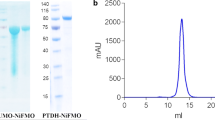Abstract
Previous research identified several microorganisms and pathways capable of degrading the mycotoxin fumonisin B1 (FB1). Degradation of FB1 by microorganisms seems to comprise two essential steps: hydrolysis to hydrolyzed fumonisin B1 (HFB1) and deamination of the hydrolysis product. One of the previously studied microorganisms was the Gram negative bacterium ATCC 55552. The gene corresponding to the first step of FB1 degradation in this bacterium was identified, but the genetic basis for deamination of the hydrolyzed intermediate remained unexplained (Duvick et al. 2000, PCT patent application WO200004158). Here we report the sequence and HFB1-deaminating activity of a novel aminotransferase encoded by the bacterium ATCC 55552. The corresponding gene was identified, sequenced, and over-expressed in Escherichia coli. Cell lysates of the recombinant E. coli strain showed distinct HFB1-deaminating activity in the presence of pyridoxal phosphate and pyruvate, as was demonstrated by liquid chromatography–mass spectrometry. Thus, we suggest the novel enzyme to be part of the fumonisin catabolic pathway of the bacterium ATCC 55552.


Similar content being viewed by others
References
Altschul S, Gish W, Miller W, Myers E, Lipman D (1990) Basic local alignment search tool. J Mol Biol 215:403–410
Benedetti R, Nazzi F, Locci R, Firrao G (2006) Degradation of fumonisin B1 by a bacterial strain isolated from soil. Biodegradation 17:31–38. doi:10.1007/s10532-005-2797-y
Blackwell B, Gilliam J, Savard M, David Miller J, Duvick J (1999) Oxidative deamination of hydrolyzed fumonisin B1 (AP1) by cultures of Exophiala spinifera. Nat Toxins 7:31–38
Duvick J, Rood T, Maddox J, Wang X (1998) Fumonisin detoxification enzymes. United States Patent US 5,716,820
Duvick J, Maddox J, Gilliam J (2000) Compositions and methods for fumonisin detoxification. PCT patent application WO200004158
Flynn T, Stack M, Troy A, Chirtel S (1997) Assessment of the embryotoxic potential of the total hydrolysis product of fumonisin B1 using cultured organogenesis-staged rat embryos. Food Chem Toxicol 35:1135–1141. doi:10.1016/S0278-6915(97)85466-X
Harrison L, Colvin B, Greene J, Newman L, Cole JJ (1990) Pulmonary edema and hydrothorax in swine produced by fumonisin B1, a toxic metabolite of Fusarium moniliforme. J Vet Diagn Invest 2:217–221
Heinl S, Hartinger D, Thamhesl M, Vekiru E, Krska R, Schatzmayr G, Moll W, Grabherr R (2010) Degradation of fumonisin B1 by the consecutive action of two bacterial enzymes. J Biotechnol 145:120–129. doi:10.1016/j.jbiotec.2009.11.004/s0168-1656(09)00503-3
Humpf H, Schmelz E, Meredith F, Vesper H, Vales T, Wang E, Menaldino D, Liotta D, Merrill AJ (1998) Acylation of naturally occurring and synthetic 1-deoxysphinganines by ceramide synthase. Formation of N-palmitoyl-aminopentol produces a toxic metabolite of hydrolyzed fumonisin, AP1, and a new category of ceramide synthase inhibitor. J Biol Chem 273:19060–19064. doi:10.1074/jbc.273.30.19060
Kellerman T, Marasas W, Thiel P, Gelderblom W, Cawood M, Coetzer J (1990) Leukoencephalomalacia in two horses induced by oral dosing of fumonisin B1. Onderstepoort J Vet Res 57:269–275
Marasas W, Jaskiewicz K, Venter F, Van Schalkwyk D (1988) Fusarium moniliforme contamination of maize in oesophageal cancer areas in Transkei. S Afr Med J 74:110–114
Merrill AJ, Wang E, Gilchrist D, Riley R (1993) Fumonisins and other inhibitors of de novo sphingolipid biosynthesis. Adv Lipid Res 26:215–234
Merrill AJ, Sullards M, Wang E, Voss K, Riley R (2001) Sphingolipid metabolism: roles in signal transduction and disruption by fumonisins. Environ Health Perspect 109(Suppl 2):283–289
Ochman H, Gerber A, Hartl D (1988) Genetic applications of an inverse polymerase chain reaction. Genetics 120:621–623
Regier J, Shi D (2005) Increased yield of PCR product from degenerate primers with nondegenerate, nonhomologous 5′ tails. Biotechniques 38:34, 36, 38
Sambrook J, Russell DW (2001) Molecular cloning, vol 1–3, 3rd edn. Cold Spring Harbor Laboratory Press, New York
Seiferlein M, Humpf H, Voss K, Sullards M, Allegood J, Wang E, Merrill AJ (2007) Hydrolyzed fumonisins HFB1 and HFB2 are acylated in vitro and in vivo by ceramide synthase to form cytotoxic N-acyl-metabolites. Mol Nutr Food Res 51:1120–1130. doi:10.1002/mnfr.200700118
Täubel M (2005) Isolierung und Charakterisierung von Mikroorganismen zur biologischen Inaktivierung von Fumonisinen. Dissertation, University of Natural Resources and Applied Life Sciences, Vienna
Voss K, Howard P, Riley R, Sharma R, Bucci T, Lorentzen R (2002) Carcinogenicity and mechanism of action of fumonisin B1: a mycotoxin produced by Fusarium moniliforme (=F. verticillioides). Cancer Detect Prev 26:1–9. doi:10.1016/S0361-090X(02)00011-9
Wang E, Norred W, Bacon C, Riley R, Merrill AJ (1991) Inhibition of sphingolipid biosynthesis by fumonisins. Implications for diseases associated with Fusarium moniliforme. J Biol Chem 266:14486–14490
Zhao L, Weiner DP, Hickle L (2004) Transaminases, deaminases and aminomutases and compositions and methods for enzymatic detoxification. PCT patent application WO2004085624
Acknowledgements
We wish to thank Markus Kainz and Elisabeth Pichler from Quantas Analytics GmbH, Tulln, Austria, for collaboration on LC–MS. This work was supported in part by the Austrian Research Promotion Agency FFG.
Author information
Authors and Affiliations
Corresponding author
Rights and permissions
About this article
Cite this article
Heinl, S., Hartinger, D., Thamhesl, M. et al. An aminotransferase from bacterium ATCC 55552 deaminates hydrolyzed fumonisin B1 . Biodegradation 22, 25–30 (2011). https://doi.org/10.1007/s10532-010-9371-y
Received:
Accepted:
Published:
Issue Date:
DOI: https://doi.org/10.1007/s10532-010-9371-y




